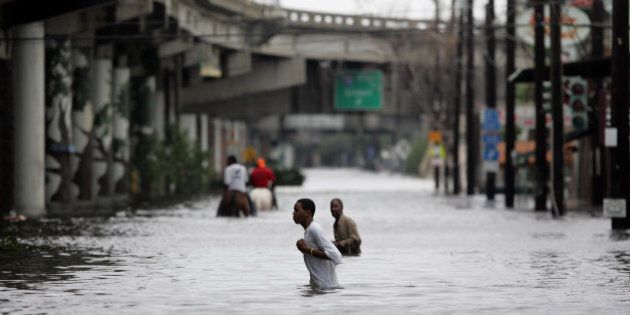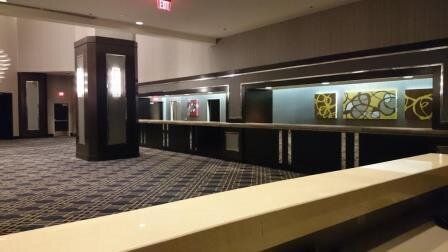
There are some common things between Calgary and New Orleans that are not immediately apparent. With a distance of nearly 4,000 kilometres, a time zone apart, and dramatically different weather and terrain, it makes sense why it would be hard to miss the common links. Despite these differences:
Both cities have cool nicknames: NOLA and Big Easy versus Cowtown and Stampede City.
Both have annual outdoor events of international fame -- Mardi Gras, Stampede.
Both have a dominant industry that plays a huge impact on its economy -- tourism and conventions, the oil patch.
And both have experienced one of the biggest natural disasters in North America.
New Orleans suffered terribly from Hurricane Katrina in 2005, while Calgary endured the flood in 2013. Both claimed to be the costliest natural disasters in their respective countries.
It was for this last reason that inspired me to visit New Orleans for the first time in 2014. Since I had lived through Calgary's flood, I was curious to see, or rather compare, how the two cities endured their respective misfortunes. Therein lied my assumption error in thinking that the two cities could be compared in terms of the devastation caused and the revitalization process thereafter.
"The 2013 flood is a distant memory,"
- owner/operator of Calgary restaurant in a radio interview in 2014
Apples to Oranges
Whereas the Alberta flood impacted Calgary significantly, with over 75,000 people displaced from their homes, Canadian Forces deployed in the rescue efforts, and damages estimated in excess of $1.7 billion (across Alberta), the direct impact of it essentially was restricted to a certain section of the City, while leaving the majority untouched. In fact, so dramatic was the focus of the impact on a specific zone that majority of Calgarians who were not impacted by it would not know of the dramatic events unfolding in the city core if not for the media reports. The city core was back in operation within a week and majority of the small retail businesses that were directly impacted were more or less up and running by Stampede season.
On the contrary, the estimated damage from Hurricane Katrina was estimated at $108 billion (2005 USD) with nearly 275,000 people displaced across the regions affected by it. The impact lasted years following its aftermath and continues to play an integral role in defining this city.
In 2015, the City of New Orleans is going to have its 10th anniversary of Hurricane Katrina. The recovery and revitalization since 2005 has been a long arduous road. The effort did pay off in 2013 when the direct revenue from tourism finally surpassed the level in the year prior to Hurricane Katrina.

While first-time visitors to NOLA typically plan a trip around Mardi Gras season (late Jan to early Feb), I specifically decided to make my first jaunt to see it in context of how it had evolved, particularly with an emphasis on businesses involved in the tourism sector. I visited local businesses, national chains, communities, and talked to many locals to hear their stories on how Katrina affected their business and how they have fared over the years. Here are their stories:
Joe's Story
Joe Spadaro was working at Landry's Seafood restaurant in the French Quarter when the flooding occurred. Contrary to popular belief, the historic French Quarter of New Orleans was not affected to the extent that the other places did. I met Joe at the Landry's Seafood located on Lakeshore Drive that fronts on to Lake Pontchartrain. Unless you knew about its history you would not think this place was on the first point of impact of the storm.
Joe described the state of chaos during the storm in a way that only a local could describe it. The water levels had risen up to the second level of the restaurant. As one might have expected, the restaurant suffered significant damage to property, inventory and business loss. Amazingly, the structures survived the brutal force of the storm. Today the business and location is back to normal operations.

Antoine's Story
Search for images of French Quarter or Bourbon Street online and you are bound to come across the photo of the iconic building that houses the oldest running restaurant in USA.

Antoine's Restaurant has been operated by the same family, without interruption, for 167 years. That record nearly broke during the storm. Nearly! The famous French Quarter was least affected by the storm or the floods so there was not direct impact to the restaurant. The disruption came from the restaurant staff whose homes and lives had been directly impacted during the hurricane.
Antoine's cuisine is original New Orleans with French and Creole backgrounds. This place is all about old school service and class. One of the classier things about New Orleans (and the southern culture of USA in general) is their continued tradition of dressing up even for the typical dining experience.

Kellie and Andrew's Story
Andrew Brott and Kellie Grengs are locals. Kellie heads up the Freret Street Improvement District (an uptown location of NOLA that was hit hard during the storm). Kellie and Andrew invited us in to their house for drinks and snacks when we arrived at Freret to check out the locale. They shared stories of how their homes got flooded and how the neighborhood became derelict and dying. Today, thanks to the revitalization efforts spearheaded by Kellie's organization, Freret is on its way to become one of the trendiest neighborhoods in the City.
Whitley's Story
Whitley Donsereaux left NOLA several years ago to pursue opportunities in the hospitality sector outside the state given the dramatic dearth of jobs in this industry in the immediate years following Katrina. An initial stint at a Hyatt Regency led her back to NOLA to work in media relations with the Hyatt Regency New Orleans, which underwent a six year restoration period. Today it has emerged as one of the preeminent locations within the Hyatt banner and is regarded as an iconic landmark of NOLA. Whitley indicated that her return to NOLA was fortuitous since it not only brought her back home but also offered several avenues of growth and opportunities in the industry in this city for young professionals. I had this sentiment repeated several times with others I talked to. NOLA is bringing back the energy through commerce and the vibe is felt throughout the people in the city.
The image below is of the former lobby of the Hyatt that became ground zero for the recovery efforts. While no longer in use it remains intact after the renovation to serve as a piece of its legacy.

An Indie Band's Story
So Long Storyland is a young and thriving indie band that comprises locals singer Sophia Preston and songwriter Andrew deBuys. The collaboration of this duo has put the band in the forefront of eclectic and innovative music to come out of the city of jazz. Andrew was away at college and Sofia was just a child when Katrina hit so both didn't experience it firsthand. But Andrew's father lost his home. He lived on the very street where the canal broke in lakeview. He stayed on that property in a trailer for a few years until they were able to rebuild. Out of every tragedy evolves hope. Out of hope comes inspiration. Some of the songs by the band have indeed been inspired from that period. You can check out a detailed interview here with the band to read about new digs, eateries, shopping and cool neighborhoods from a local artist's point of view.

Stories Abound
New Orleans is a storyteller's dream come true. Given its legacy and origins (and perhaps, in my case, author John Grisham to an extent) numerous stories abound. The people, the buildings, the streets, the venues, the locales - all have a different flavor in their stories that are rich and varied. Stories of the legends of jazz, ghost tours night walks, tours on Hurricane Katrina, an afternoon with boat operators in the Bayous, all abound to a culmination of stories that are as vivid and vibrant as its famous Cajun and Creole cuisine.

No more talk about the towns that won't be saved
New Roads got washed,
St. Rose got razed
Oh, Oh no, the flood is rising in the streets
Oh, too bad, too late, the flood is gonna break
Oh, The rain, the wind,
The house is caving in
Black cloud, no fair
I don't want the flood to break
- from the song THE FLOOD by NOLA Indie Band So Long Storyland
Disclaimer: Portions of this post appeared originally on this author's blog and have been reproduced in here with full acknowledgement by this author.